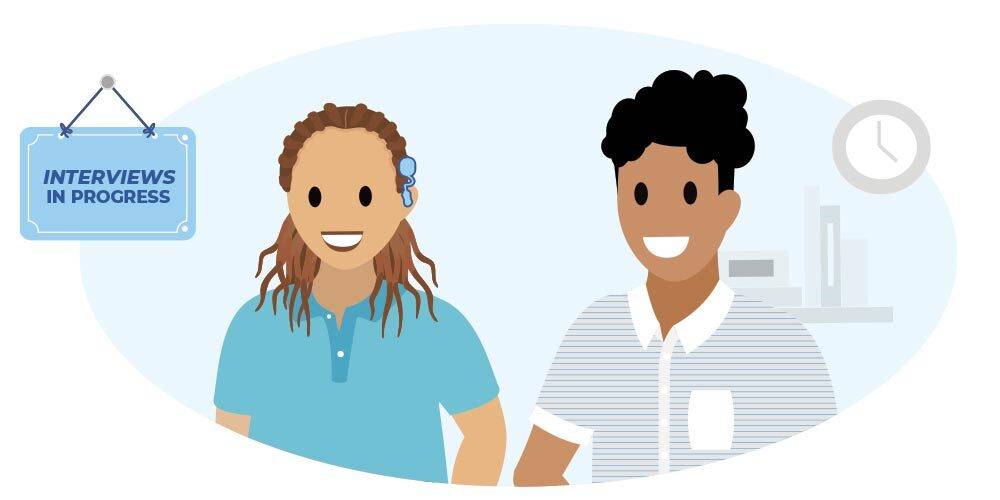Broaden Your Talent Pool
Learning Objectives
After completing this unit, you’ll be able to:
- Develop a plan to ensure your talent pool is broad so you can access top talent.
- Explain why providing accommodations throughout the hiring cycle is critical to creating equal opportunities for all.
- Identify resources for sourcing a broad talent pool, including those with disabilities
People with disabilities experience life in unique ways that lend them invaluable perspectives. Many of them find that their disabilities have helped them become expert critical and creative thinkers.
These problem solving abilities are critical in the workplace—especially in tech—where employees must constantly find new solutions to keep up with the dynamic nature of product innovation.

This is why it is important to build a strategy that allows you to access a broad talent pool and ensure equal opportunities and experiences for all. There are three main steps to building this strategy.
- Identify and address recruiting obstacles.
- Weave accommodations throughout the hiring cycle.
- Proactively source a broad pool of candidates.
Let’s walk through each of these in detail.
1. Identify and address recruiting obstacles.
The first step to overcoming barriers is to find them. Start by auditing your hiring process to understand where obstacles exist that could impede equal opportunities for all to succeed in the process. For instance, check to make sure your virtual interviews are conducted on a platform that supports captioning.
For people with non-apparent disabilities or neurodiverse accommodation needs, small obstacles can be roadblocks. Be sure to consider such obstacles as a person not knowing how to find a specific office. (Consider having someone greet all candidates and escorting them to the proper room.)
You can also use resources, such as Inclusively’s Accommodations Insights Dashboard, to get insight into the most frequently requested accommodations. This will help you better understand the needs of both today’s candidates and your existing workforce, so you can identify opportunities to fill gaps in your own hiring process.
2. Weave accommodations throughout the hiring process.
From the moment a candidate reaches out—or that you reach out to a candidate—your hiring process should be accessible. That means that your “upload resume” button should have a properly coded label so that assistive technologies can recognize it. It means that your hiring manager should use a caption-enabled video platform when conducting virtual interviews. And it means that in interviews, language should be clear and concise.
From the first moment a candidate encounters your job posting, they should find it easy and intuitive to request accommodations. Better yet, recruiters can standardize this process by proactively asking all candidates if they require any accommodations, rather than putting the onus on the applicant.
It’s a common misconception that providing accommodations is expensive. The majority of workers with disabilities do not need formal accommodations to perform their jobs at all, and for those who do, the cost is usually minimal. A study by the Job Accommodation Network (JAN) showed that 58% of accommodations don’t cost anything to implement, while the rest average just $500.
Below is a non-exhaustive list of accommodations that cost nothing to implement, but can make a world of difference in empowering all candidates, including people with disabilities, to bring their best selves to the hiring process.
- Provide all relevant information, details, and context well in advance of each interview or meeting. Details should include location, parties involved, and their roles.
- Be mindful of rescheduling and any changes to provided details.
- Build in breaks for longer panels and multi-interview sessions to allow for candidates to refocus, take medication, and so forth.
- Avoid soft immeasurable skills tests and personality profiles, as these give way to unconscious bias to the detriment of candidates with disabilities. For instance, candidates who answer honestly and don’t immediately “fit the mold” can distract hiring managers from the actual hard skills the job requires.
3. Proactively source a broad talent poolA number of platforms exist to help you broaden your talent pool to include talented candidates with disabilities. Below are a few places to get started.
Disability:IN: Next Gen Program
Consider sourcing top talent for your intern talent pool from a disability serving organization, such as the Next Gen program through Disability:IN. The NextGen Leader Initiatives are committed to increasing opportunities for individuals who represent all segments of society.
In order to meet the growing demand for talent in the Salesforce ecosystem, we support and enable programs that train professionals with disabilities, ensuring they are equipped with in-demand Salesforce skills and certifications. We provide supplemental curriculum for users of assistive technology, support accommodation requests, and provide job seeker support for Trailblazers with disabilities.
This nonprofit organization partners with employers across the United States. Its mission is to advance the professional opportunities for people with disabilities by providing technical training and job placement assistance.
This workforce inclusion platform connects job seekers with disabilities with employers who are committed to attracting top talent from a broad pool of candidates.
Ready to Recruit?
The disability community is one of the largest untapped talent pools in the United States. Now that you understand more about the unique skills and experience people with disabilities bring to organizations, consider the steps you will take to build a broad talent pool. Build your recruiting plan and reach out to one of the many resources available to create a pipeline of qualified candidates.
Resources
- Salesforce.com: A11y for Work
- External Site: Blind Institute of Technology
- External Site: Inclusively